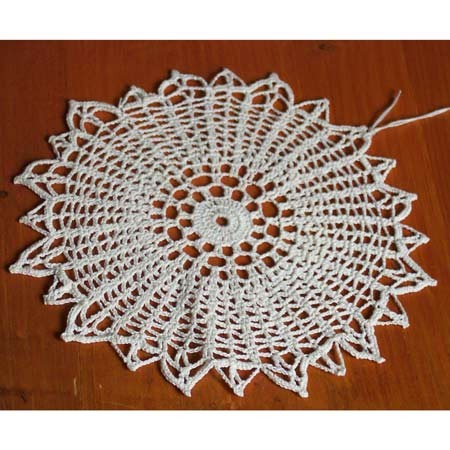Crochet Stairs Small Doily
Crocheting a small doily to decorate your stairs is a delightful and creative way to add charm to your home décor. The intricate patterns and delicate stitches of a crochet stairs small doily can bring a touch of elegance and sweetness to even the smallest corner of your house. Whether you choose soft pastel colors for a cozy feel or vibrant hues to make a statement, the process of creating this unique piece is not only enjoyable but also rewarding. As you work on each stitch, envision how the doily will enhance the aesthetic appeal of your steps and fill the space with warmth and beauty. So, grab your crochet hook, pick out your favorite yarn, and let your imagination run wild as you embark on this enchanting craft project.

Size :7" (17 cm.) diameter
Material :Cebelia 20, color white, hook 1.25 (US 10)
Stitches :ch, sl st, sc, dc,tr, picot = 3 ch, sl st in first ch
Difficulty: medium
Directions
Start with 9 ch
1. 18 dc in loop; join with sl st to first st.
2. 2 dc in ea dc; join with sl st to first st.
3.*2 dc in next dc, 3 ch, sk 2 dc*; Repeat * to * 12 times, join with sl st to first st.
4.* 2 tr in next sp, 4 ch*; Repeat * to * 12 times, join with sl st to first st.
5. * (tr on next tr) twice, 3 ch, 2 tr on next sp, 3 ch*; Repeat * to * 12 times, join with sl st to first st.
6. *(dc on next tr) twice, 3 ch, sc in next sp, 3 ch*; Repeat * to * 24 times, join with sl st to first st.
7. *(sc on next dc) twice, 3 ch, tr in next sc, 3 ch*; Repeat * to * 24 times, join with sl st to first st.
8. *(dc on next sc) twice, 3 ch, sc in next sp, 3 ch*; Repeat * to * 24 times, join with sl st to first st.
9.*(sc on next dc) twice, 3 ch, tr in next sc, 3 ch*; Repeat * to * 24 times, join with sl st to first st.
10.*(dc on next sc) twice, 3 ch, sc in next sp, 3 ch*; Repeat * to * 24 times, join with sl st to first st.
11..*(sc on next dc) twice, 4 ch, tr in next sc, 4 ch*; Repeat * to * 24 times, join with sl st to first st.
12.*(dc on next sc) twice, 4 ch, sc in next sp, 4 ch*; Repeat * to * 24 times, join with sl st to first st.
13.*(sc on next dc) twice, 4 ch, tr in next sc, 4 ch*; Repeat * to * 24 times, join with sl st to first st.
14.*(dc on next sc) twice, 4 ch, sc in next sp, 4 ch*; Repeat * to * 24 times, join with sl st to first st.
15.*(sc on next dc) twice, 4 ch, tr in next sc, 4 ch*; Repeat * to * 24 times, join with sl st to first st.
16. *(tr on next sc)twice, 4 ch, sc on next tr, 4 ch, (tr on next tr)twice, 3 ch, (tr, 2 ch, tr) on next tr, 3 ch*; Repeat * to * 12 times, join with sl st to first st.
17. *4 sc in next 4-ch sp, 1 ch, 4 sc in next 4-ch lp, 6 ch, (tr, 3 ch, tr) in next 2-ch sp, 6 ch*; Repeat * to * 12 times, join with sl st to first st.
18.* 5 ch, (tr, picot, tr) in 1-ch sp, 5 ch, 6 sc in next 6-ch sp, (2 sc, picot, 2 sc) in 3-ch sp, 6 sc in next 6-ch sp*; Repeat * to * 12 times, join with sl st to first st. Cut thread, weave in ends.
N.B.
- Substitute ever (also if not explicitly said) first st in a row as follows:
- first sc with 1 ch, sc;
- first hdc with 2 ch;
- first dc with 3 ch;
- first tr with 4 ch...and so on;
- When you read «sl st to <location>», where the location is not immediately contiguous to last st, this means of course «an appropriate number of sl sts for reaching <location>».
- Also if I do not specify it, if you lasted prev row on a st (say st1), while you must start next row in another st (say st2), make an appropriate number of sl sts to reach st2.